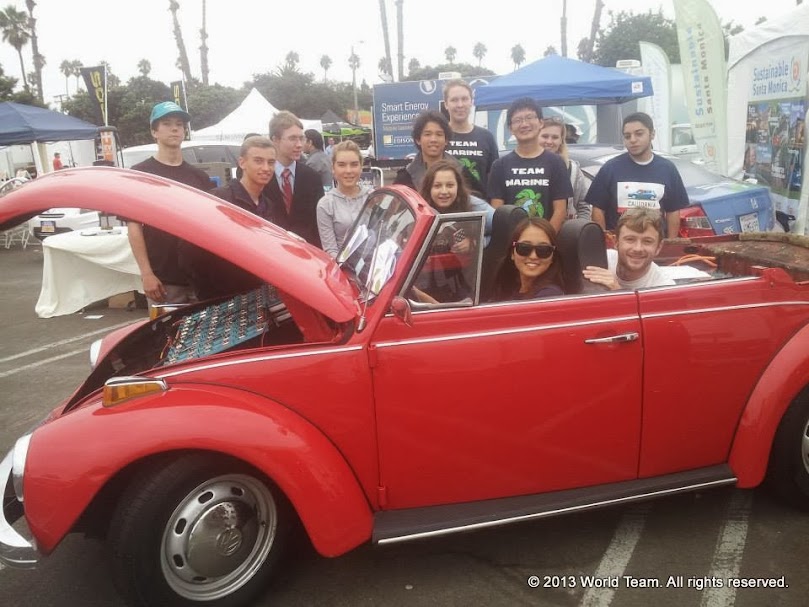
The BMW i3
The 8th annual AltCar Expo continued in Santa Monica, with marked change and growth. The AltCar Expo is a great opportunity to ride and drive some of the latest alternative vehicles and understand ways you can do your part with Climate Change. World Team Now visited the Expo on Friday, during the “Fleet Day”, and Saturday for “Public Day”. There we so many inspirational highlights at this year’s event (see World Team Now’s photo album).
The AltCar Expo had the latest in various Alternative Technology Vehicles: Electric, Hydrogen, Propane, Natural Gas, Bio-Diesel, Hybrid but since World Team Now is focused on long term solutions that are sustainable “cradle to cradle” –we focus on electric, which can be charged by renewable energy source like; solar, wind or hydro. We love the concept of the solar boat.

Ford’s C-Maxx Energi and Fusion informational poster
Good old fashion American Ford and Chevy are now gaining strength in the market with electric vehicles and plug-in electric vehicles(PHEVs). The C-Max Energi from Ford is a promising vehicle that may lead the market in PHEVs eventually, but we could not fully evaluate that from our one test drive experience. What is evident is the number of options from each manufacturer who are all now entering either the hybrid, plug-in hybrid and all-electric vehicles with products to choose from, like Chevy’s new “Spark”. Nissan continues to surprise improving on their leading EV, here with Nissan’s souped-up Leaf, the Nissan Leaf Nismo RC.  BMW’s i3 EV has range and is part of a new brand, BMW i, consisting of EVs and hybrids. Also, we were impressed by Genze (more than a scooter), Team Marine, the international flair of participation from the Netherlands constituency, and Lumos.
BMW’s i3 EV has range and is part of a new brand, BMW i, consisting of EVs and hybrids. Also, we were impressed by Genze (more than a scooter), Team Marine, the international flair of participation from the Netherlands constituency, and Lumos.

Lumos’ solar carport
Lumos has a kit solar carport that has game-changing opportunities to source your own energy and help address your utility’s high demand to supply electricity by being able to take advantage of what’s called arbitrage energy by selling back to the electrical grid. V2G (vehicle to grid — see WTN’s IEEE article “Vehicle Electrification: Status and Issues” for more on this) with the option of a net-zero grid-tied building is one of the significant ways each individual can do their part to combat Climate Change and learn to better live in balance with our natural resources. EPA made a solid step in limiting emissions Friday of new coal plants to 1,100 pounds of carbon-dioxide per megawatt-hour of power produced.

Team Marine in “Volts Watson”
The heart of the inspiration was Santa Monica High School’s club Team Marine, there to unveil their newly transformed vehicle named Volts Watson – an old Volkswagen Beetle from 1971 that is now all-electric (see photo album). It was a heartwarming experience to see one of the children that I taught to skate, ocean swim and many other of his life’s first experiences, Matthew Zarken, be part of Team Marine. His brother Nicholas was a volunteer for World Team Now last year at AltExpo and wrote this about his experience.

The RAV4 continues
Please come be part of the Team — see Team Marine’s transformed car, World Team in action, and be inspired to take action — be part of “Draw the Line” on Climate Change, as day of global action against the Keystone XL pipeline, and be for renewable action with your choice to choose your source of energy and what you drive. There were many opportunities to see the evolution of the electric vehicle from its beginning to now – the growth is remarkable. there was a new milestone with more than 10,000 EVs sold in August. “The 35 million EVs sold in 2012 will rise 3.6 times to nearly 129 million in 2022”, (worldwide and including e-bikes) as cited in this report that demonstrates how the vehicle game is changing. Electrifying transportation, like with the solar boat demo-ed here

At the solar boat from World Team Now: Jacinta Camacho Kaplan, Laura Fercano Demieri, Liana Foksheneanu, and Suzanne Maxx
or connecting directly to renewable energy source– is a sustainable way to go, especially as we improve energy storage capabilities. People are beginning to understand the connection between economics and the ecological. There is greater weight placed in their choices and actions when thinking about the next generation to consider more carefully. However public adoption and dealership education has just begun – both of these elements along with supportive policy will contribute to long term rollout of electric vehicles significantly.



